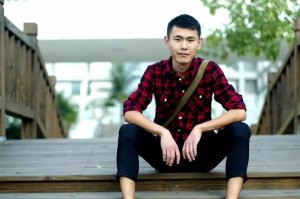Taotao Wang: Plant Physiology First Author

 Taotao Wang, first author of “Alternative 3′-untranslated regions regulate high salt tolerance of Spartina alterniflora“
Taotao Wang, first author of “Alternative 3′-untranslated regions regulate high salt tolerance of Spartina alterniflora“
Current Position: Shanghai Jiaotong University, College of Life Science and Technology, Research associate.
Education:
2016/09-2020/06, Fujian Agriculture and Forestry University, Forest tree genetics and breeding, PhD
2014/09-2016/06, Fujian Agriculture and Forestry University, Master of Forestry
2010/09-2014/06, Henan Polytechnic University, Bachelor of Science
Non-scientific Interests: Basketball, running
Brief bio:
During my doctoral study in Dr. Liuyin Ma’s group at Fujian A&F University, my research interests mainly focused on unveiling the transcriptional and post-transcriptional gene expression regulation mechanisms of growth and stress responses in forestry grasses: Moso bamboo and Spartina alterniflora. My research results have been published in the Plant Journal, Plant and Cell Physiology, Plant Science, and International Journal of Molecular Science. In this study, we found that high salt stress could induce mRNA 3′ UTR (untranslated region) lengthening in S. alterniflora (Spartina alterniflora), a monocotyledonous halophyte in salt march, through integrating second-generation high-throughput sequencing of the 3′ ends of mRNA and third-generation PacBio full-length sequencing. By molecular experiments validation, we proved that 3′ UTR lengthening was important for maintaining the mRNA stability and protein synthesis of salt-tolerant genes such as SaHKT1 in S. alterniflora. Over-expression of 3′ UTRs with the lengthening region of SaHKT1 enhanced the expression of other salt-tolerance genes in a post-transcriptional regulatory element (AU-rich element)-dependent manner. Further results suggested that 3′ UTR lengthening originated from the alternative polyadenylation key regulatory factor SaCPSF30. Overall, our results revealed a SaCPSF30-SaHKT1 3′ UTR-Salt-tolerant gene expression regulatory model in S. alterniflora and provided a role of 3′ UTR in regulating the plant stress response by integrating alternative polyadenylation and post-transcriptional regulatory elements.
姓名:王涛涛
目前职位:上海交通大学,生命科学技术学院,助理研究员
教育经历:
2016/09-2020/06,福建农林大学,林木遗传育种,博士学位
2014/09-2016/06,福建农林大学,林业,硕士学位
2010/09-2014/06,河南理工大学,理学学士学位
兴趣爱好:打篮球,跑步
个人简介:
在福建农林科技大学海峡联合研究院马留银课题组攻读博士学位期间,我的研究兴趣主要集中在揭示林草(毛竹和互花米草)生长和胁迫答应的转录与转录后基因表达调控机制。我的研究成果发表在《Plant Journal》、《Plant and Cell Physiology》、《Plant Science》和《International Journal of Molecular Science》上。在本研究中,我们通过整合mRNA 3′ 末端二代高通量测序和PacBio三代全长测序发现: 高盐胁迫可以诱导滨海盐生植物互花米草(Spartina alterniflora)mRNA 3′ UTR(非翻译区)的延长。通过分子实验验证,证明3′ UTR延长对于维持互花米草中SaHKT1等耐盐基因mRNA的稳定性和蛋白合成具有重要意义。过表达SaHKT1延长的3′ UTR增强了其他耐盐基因的表达,并且这种调控是依赖于3′ UTR 延长区域内转录后调控元件:AU-rich elements。最后,我们也发现3′ UTR延长源于可变多聚腺苷酸化调控因子SaCPSF30的调控。总体而言,我们的结果揭示了互花米草中SaCPSF30-SaHKT1 3′ UTR-耐盐基因表达的调控模型,并通过整合可变多聚腺苷酸化和转录后调控元件,为3′ UTR调节植物响应环境胁迫提供了参考。



